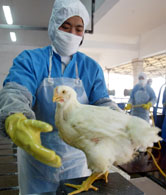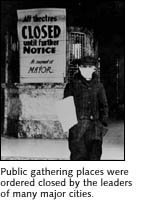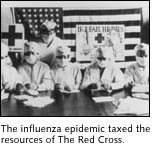| (insert your NIE or newspaper logo here) |
Weekly Online LessonOnline Lesson ArchiveGrade Level: 6-8
|
Bird Flu Worries Humans
 Last
week President George W. Bush began preparing for a killer that's more
covert—and potentially more deadly—than any terrorist attack or
hurricane threat.
Last
week President George W. Bush began preparing for a killer that's more
covert—and potentially more deadly—than any terrorist attack or
hurricane threat.
On Friday, October 7, 2005, Bush met with vaccine makers and asked them to increase development and production of vaccines that can combat avian influenza.
But why is Bush—along with leaders and health officials around the world—worried about birds coming down with the flu?
This particular brand of bird flu, called H5N1, is a highly contagious disease that is often carried by migratory birds but primarily infects and kills domestic poultry (chickens, ducks and turkeys). Millions of birds in 11 countries have died from it.
But it's not this loss of birds that has sparked such human concern. It's the fact that human cases of bird flu began appearing in Asia in 1997, so far infecting at least 130 people and killing more than half of those infected.
While the spread of this flu from birds to humans is rare and the current death toll low, the probability of transmission from bird to human—and from human to human—grows daily. And although it has been generally restricted to Asian countries, human cases have also been reported in Indonesia over the last several weeks.
It's possible that this bird flu could eventually spread into the United States. In fact, in 1918 that's exactly what happened; a bird flu crossed over to humans and became highly contagious, killing millions of Americans within 10 months.
Fortunately, medicine, technology, and disease awareness have greatly improved over the last century, allowing us to better prepare for and perhaps avoid such a devastating pandemic.
During this week's lesson you'll journey to Asia to see for yourself how the bird flu has affected people's health and lifestyles, and how officials have been responding to this threat. You'll also review how the deadly flu of 1918 spread from America's heartland in Kansas to the entire United States.
Bird Flu's Threat
 Begin
your journey at PBS through the Wide
Angle view of H5N1
- Killer Flu.
Begin
your journey at PBS through the Wide
Angle view of H5N1
- Killer Flu.
Read the introduction and briefing, and then Watch Online the four video clips, starting with Part 1: Thuan's Story.
How exactly do doctors think Thuan became infected? How does this flu affect the lungs?
Next, watch Part 2: Tracking the Virus.
How can the "cascade effect" occur? Why are doctors looking at regular human influenza occurrences as well as bird flu cases? What is the typical series of symptoms a patient experiences?
In Part 3 you will learn how this is An Evolving Threat.
Why is it worrisome to some doctors that some people survive the bird flu? Why does the infection of the nurse imply a larger threat? How could the virus spread from infected Asians to others worldwide? What kinds of things are health officials doing to help curb the spread of infection? Why do some people try to get around these precautionary measures?
Lastly, watch Part 4: Preparing for a Pandemic.
How do the lifestyles and traditions of most Asians—in both rural and urban areas—make residents so susceptible to getting the bird flu? How prepared are doctors to deal with a sudden human spread of H5N1? What limitations do they face?
 Now
check out the Interactive
Map to track the spread of H5N1 through Asia so far.
Now
check out the Interactive
Map to track the spread of H5N1 through Asia so far.
Read the introduction, and then click on the country names for detailed information.
In what country has the largest number of human cases been reported? Why do you think the frequency of infections have decreased in an area? Why are cases in China unknown?
Before leaving Wide Angle, sit in on the Anchor Interview with Dr. Anthony Fauci (or read the Transcript).
What would be the tell-tale signs that a pandemic spread has begun? What can health officials do to help control the spread? What kinds of vaccines are being developed that may protect people from exposure? How long might it take to make enough vaccine to protect everyone from this bird flu? How many doses are currently available? About how much will it cost to make enough vaccine?
America's Epidemic
 To
better understand how a flu epidemic might affect America, you simply
need to look back to the last century. Let's explore the American Experience to see what exactly happened
when the Influenza
of 1918 hit this country.
To
better understand how a flu epidemic might affect America, you simply
need to look back to the last century. Let's explore the American Experience to see what exactly happened
when the Influenza
of 1918 hit this country.
To begin, get a glimpse of the big picture by looking at the animated Map and accompanying chart of monthly death rates.
In which areas was the epidemic most prominent? Why do you think those areas were infected first?
Now, review at a detailed Timeline of the epidemic's events.
Why do you think military personnel were the first victims of this flu? How did health and government officials react to the spread? Why was it difficult to recruit doctors and nurses to help with flu patients? In what ways did the epidemic affect the daily lives of many Americans?
Next, explore the Special Features section, and review the city snapshots of Boston, San Francisco, and Philadelphia.
 What
were the similarities and differences between how each city was affected
and how each responded?
What
were the similarities and differences between how each city was affected
and how each responded?
Also in this section, browse through the other pages, including Among the Victims, A Letter from Camp Devens, MA, the Dr. Taubenberger Interview, the Latest Findings, and Flu Trackers.
About how long did it take between the first signs of flu symptoms and death? What kinds of strains did the epidemic put on doctors and other health care workers? About how long do scientists estimate the virus was "around" before the big epidemic took hold? Who is in charge of tracking and controlling flu viruses in the United States?
Finally, review some of the key People & Events related to the epidemic.
What was the role of Rupert Blue during the epidemic? What difference did Victor Vaughn discover between this particular flu strain and more typical ones? How exactly did The First Wave of the influenza hit the nation? Why was the government Placing Blame? In what ways were people Searching for Cures?
Newspaper Activities
Review current issues of The Salt Lake Tribune, watching for stories about H5N1 or related bird flu viruses. What are government and health care officials doing to prepare for the spread of bird flu in the United States and elsewhere? In what ways are two or more countries cooperating to combat the threat together? Are any countries reluctant to share information or implement controls that would help curb the virus? If so, what are their motives? If H5N1 has spread to any countries outside of Asia, do officials have any idea how it may have been transported to that particular location? What kind of progress is being made in developing and producing supplies more effective vaccines?
© Copyright 2005
Learners Online, Inc.
